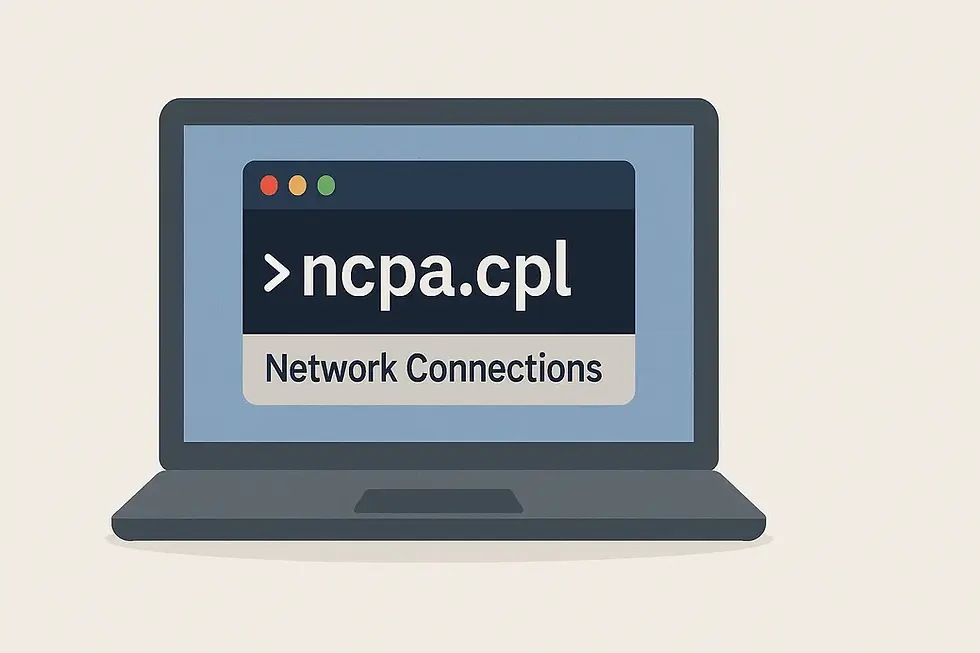How to Reset Network Settings in Windows | CMD & GUI Steps
- Kalyan Bhattacharjee

- Jun 23
- 2 min read

Overview
When your internet slows down or fails to connect, it’s often due to corrupted network configurations. Resetting your network settings can resolve most connectivity issues, and Windows offers two easy methods to do this—via Command Prompt (CMD) and the Graphical User Interface (GUI).
In this guide, we’ll walk you through both methods step-by-step, ensuring a smooth and safe reset without losing essential data.
Fix Network Issues in Minutes - The Right Way
What Does Resetting Windows Network Settings Do? 🔧
Resetting network settings in Windows will:
Remove all saved Wi-Fi networks and passwords
Reinstall all network adapters
Set everything back to default TCP/IP settings
Clear DNS cache and custom proxy/VPN settings
This is useful when you’re facing:
No internet access
IP conflict errors
Slow or inconsistent Wi-Fi
Issues after installing new software or updates
Method 1: Reset Network via CMD (Command Prompt) 🖥️
Step-by-Step Guide (CMD):
Open CMD as Administrator
Press Windows + S, type CMD
Right-click Command Prompt > Choose Run as Administrator

Enter the Following Commands One by One:
netsh winsock reset
netsh int ip reset
ipconfig /release
ipconfig /renew
ipconfig /flushdns
🔁 Explanation of Command Sequence
What does these commands do:
Command | What It Does |
netsh winsock reset | Resets Winsock catalog (fixes socket-related errors). |
netsh int ip reset | Resets TCP/IP stack to default (repairs IP configuration issues). |
ipconfig /release | Releases current IP address assigned by DHCP. |
ipconfig /renew | Requests a new IP address from DHCP. |
ipconfig /flushdns | Clears DNS cache (fixes domain resolution issues). |
Method 2: Reset via GUI (Windows Settings) 🧭
Step-by-Step Guide (GUI):
Go to Settings:
Press Windows + I to open Settings

Navigate to:
Network & Internet > Advanced Network Settings
Click on “Network Reset”
Scroll to the bottom and click on Network Reset

Confirm Reset
You’ll see a warning; click Reset now
Your PC will restart after 5 minutes
Bonus Tip: When Not to Reset Network Settings 📌
Avoid resetting if:
You’re using custom VPN configurations you can’t reconfigure
On a corporate or shared network (resetting may break access)
You just need to flush DNS or restart the adapter (lighter fixes may work)
Best Practices After Reset ✅
Reconnect to your Wi-Fi manually
Reconfigure VPNs or static IPs
Run a speed test to verify improvements
Check for Windows or driver updates

Wrapping Up 🧠
Resetting network settings in Windows—whether via CMD or GUI—is a powerful and safe way to troubleshoot most connectivity issues. Just remember to backup Wi-Fi credentials or VPN settings if needed.
Have you recently experienced persistent network issues? Try this reset process before calling your ISP—it often works like magic.
reset windows network settings, how to fix internet issues in windows, cmd network reset commands, network reset windows 11, flush dns windows 10, ipconfig reset tutorial, winsock reset windows, reset network settings windows 11, reset network settings windows 10, windows 10 reset network settings, how to reset network settings windows 10, how to reset network settings on windows 11, laptop won't connect to wifi, computer wifi won't connect, windows can't connect to this network, why is my computer not connecting to wifi, how to fix wireless internet, fintech shield







Comments